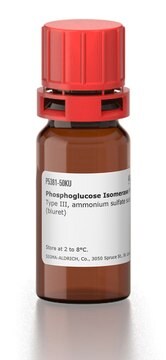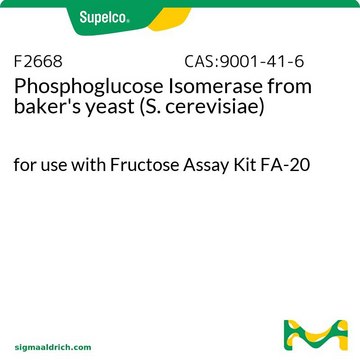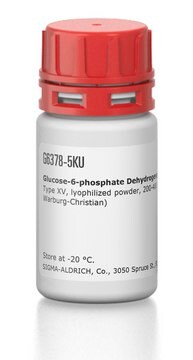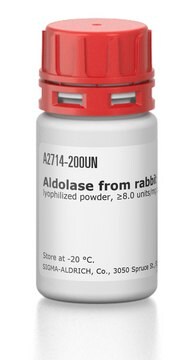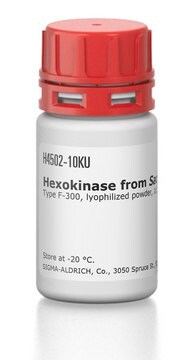Wszystkie zdjęcia(1)
Kluczowe dokumenty
P5538
Phosphoglucose Isomerase from Bacillus stearothermophilus
lyophilized powder, 300-1,000 units/mg protein
Synonim(y):
D-Glucose-6-phosphate ketol-isomerase, PGI, Phosphosaccharomutase
Zaloguj sięWyświetlanie cen organizacyjnych i kontraktowych
About This Item
Polecane produkty
Postać
lyophilized powder
Poziom jakości
aktywność właściwa
300-1,000 units/mg protein
masa cząsteczkowa
189 kDa
skład
Protein, ≥60% biuret
temp. przechowywania
−20°C
Opis ogólny
The enzyme is part of the glycolytic pathway. Also, it is important in the industrial production of fructose 1,6-diphosphate (FDP) from glucose. The molecular mass is found to be approximately 189 kDa and it consists of four subunits, each with a molecular mass of approximately 50 kDa. Optimum pH is found to be between 9-10 and the isoelectric point is 4.2.
Zastosowanie
Phosphoglucose Isomerase (PGI) is an enzyme crucial for the interconversion of D-glucose 6-phosphate and D-fructose 6-phosphate. PGI is responsible for the second step of glycolysis and is involved in glucogenesis. It is highly conserved in bacteria and eukaryotes. It is used in sugar assays to convert fructose to glucose. This product is from Bacillus stearothermophilus.
The enzyme from Sigma has been used in the determination of fructose 6-phosphate in a mutant strain of Rhizobium meliloti.
Działania biochem./fizjol.
Phosphoglucose Isomerase fuctions as an isomerase, neuroleukin, autocrine motility factor, and a differentiation and maturation mediator.
Definicja jednostki
One unit will convert 1.0 μmole of D-fructose 6-phosphate to D-glucose 6-phosphate per min at pH 9.0 at 30 °C.
Postać fizyczna
lyophilized powder containing Tris buffer
Ta strona może zawierać tekst przetłumaczony maszynowo.
Hasło ostrzegawcze
Danger
Zwroty wskazujące rodzaj zagrożenia
Zwroty wskazujące środki ostrożności
Klasyfikacja zagrożeń
Resp. Sens. 1
Kod klasy składowania
11 - Combustible Solids
Klasa zagrożenia wodnego (WGK)
WGK 3
Temperatura zapłonu (°F)
Not applicable
Temperatura zapłonu (°C)
Not applicable
Środki ochrony indywidualnej
Eyeshields, Gloves, type N95 (US)
Certyfikaty analizy (CoA)
Poszukaj Certyfikaty analizy (CoA), wpisując numer partii/serii produktów. Numery serii i partii można znaleźć na etykiecie produktu po słowach „seria” lub „partia”.
Masz już ten produkt?
Dokumenty związane z niedawno zakupionymi produktami zostały zamieszczone w Bibliotece dokumentów.
A Arias et al.
Journal of bacteriology, 137(1), 409-414 (1979-01-01)
A mutant strain of complex phenotype was selected in Rhizobium meliloti after nitrosoguanidine mutagenesis. It failed to grow on mannitol, sorbitol, fructose, mannose, ribose, arabitol, or xylose, but grew on glucose, maltose, gluconate, L-arabinose, and many other carbohydrates. Assay showed
The Kinetics and Mechanism of a Reaction Catalyzed by Bacillus stearothermophilus Phosphoglucose Isomerase.
Widjaja A, et al.
Journal of Fermentation and Bioengineering, 86(3), 324-331 (1998)
Kosei Nakajima et al.
Oncology reports, 28(6), 1953-1958 (2012-10-03)
Autocrine motility factor (AMF) plays an important role in the development of metastasis by regulating tumor cell motility. The expression of AMF is associated with metastasis in malignant musculoskeletal tumors including osteosarcoma. Recent studies indicated that hyperthermia contributes to the
Veera Kainulainen et al.
Journal of bacteriology, 194(10), 2509-2519 (2012-03-06)
Glutamine synthetase (GS) and glucose-6-phosphate isomerase (GPI) were identified as novel adhesive moonlighting proteins of Lactobacillus crispatus ST1. Both proteins were bound onto the bacterial surface at acidic pHs, whereas a suspension of the cells to pH 8 caused their
Simone Frédérique Brenière et al.
PLoS neglected tropical diseases, 6(5), e1650-e1650 (2012-06-12)
The current persistence of Triatoma infestans (one of the main vectors of Chagas disease) in some domestic areas could be related to re-colonization by wild populations which are increasingly reported. However, the infection rate and the genetic characterization of the
Nasz zespół naukowców ma doświadczenie we wszystkich obszarach badań, w tym w naukach przyrodniczych, materiałoznawstwie, syntezie chemicznej, chromatografii, analityce i wielu innych dziedzinach.
Skontaktuj się z zespołem ds. pomocy technicznej

